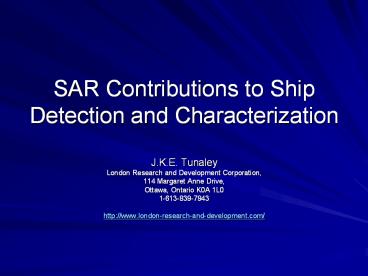SAR Contributions to Ship Detection and Characterization - PowerPoint PPT Presentation
Title:
SAR Contributions to Ship Detection and Characterization
Description:
Title: SAR Contributions to Ship Detection and Characterization Subject: SAR Contributions to Ship Detection and Characterization Author: J.K.E. Tunaley – PowerPoint PPT presentation
Number of Views:307
Avg rating:3.0/5.0
Title: SAR Contributions to Ship Detection and Characterization
1
SAR Contributions to Ship Detection and
Characterization
- J.K.E. Tunaley
- London Research and Development Corporation,
- 114 Margaret Anne Drive,
- Ottawa, Ontario K0A 1L0
- 1-613-839-7943
- http//www.london-research-and-development.com/
2
Outline
- Ship Detection
- Robustness, Timeliness, Development Costs,
K-distribution - Detection Threshold
- Wakes from Surface Ships and Internal Wave Wakes
- Space-Based AIS Performance
3
Ship Detection
- Clutter Statistics
- Remove the ship from a clutter cell
- Cut out the ship
- Handle statistically
- Estimate Clutter Parameters
- Choose a statistic
- Moments (simple)
- Logarithms
4
Threshold Calculation
- Density by steepest descents
- J.K.E. Tunaley, K-Distribution Algorithm, Sept.
2010 (www.london-research-and-development.com/K-Di
stribution Algorithm.Version2.pdf ) - Avoid Bessel functions
- Distribution/Threshold
- Suggest using expansion with polynomial
correction in shape parameter and number of looks
5
Probability Density Comparison
THRESHOLDS OF DETECTION
L 1 L 1 L 4 L 4
PFA ? Accurate Approx. Accurate Approx.
10-9 0.5 214.7 214.8 91.59 91.62
10-9 5.0 47.49 47.50 18.796 18.800
10-9 50.0 24.24 24.24 8.841 8.842
10-6 0.5 95.43 95.55 46.40 46.43
10-6 5.0 25.69 25.70 11.263 11.267
10-6 50.0 15.337 15.338 6.128 6.128
6
Parameter Estimation
- Fisher information
- J.K.E. Tunaley, Ship Detection, December 2010,
(www.london-research-and-development.com/Ship
Detection.Version3.pdf ) - Mean can be estimated reasonably accurately
- In spiky clutter shape parameter tends to require
10,000 resolution cells using moments
7
Detection Thresholds
Fig. 8. Detection thresholds for PFA 10-9, L
4 and N 100 (?), N 1000 (?), N 10,000 (?)
and N ? (?).
8
Ship Image Information
- Position
- Length (may be poor estimate)
- Heavy ship motion in high sea states
- Velocity (from wake displacement)
- Ocean going ships usually create visible wake
- D.M. Roy and J.K.E. Tunaley, Visibility of the
Turbulent Wake, March 2010 (www.london-research-a
nd-development.com/Visibility of Turbulent
Wakes.Ver2a.pdf ) - Wake characteristics depend on propulsion system
screw number and sense of rotation
9
Internal Wave Wake
Typical Brunt-Vaisala Vertical Profile.
10
Zeroth and First Modes
?0.005
?0.01
Varicose Modes
Sinuous Modes
11
Frequency-Wave Number
Modes 0, 1, 2
Determines phase and group velocities
12
Crest Pattern
Zeroth mode crest pattern for a source moving
horizontally at 5 m/s in the above profile.
13
Internal Wave Wake Conclusions
- From Crest Pattern
- Ship velocity from angle of wake (if strength of
layer known) - Maximum B-V frequency
- From Amplitudes (Tentative)
- Layer thickness/Position of vessel in layer
- Vessel size
14
Space-Based AIS Performance
- Problems
- Signal Collisions and Range Overlap
- Message 27 solution with AIS channels 3 4
(ITU-R M.2169) - FFI Theoretical Model
- Based on signal corruption with one or more
signal collisions - Extension to multiple collisions
- (www.london-research-and-development.com/Space-Bas
ed-AIS-Performance.pdf )
15
Multiple Collision Model
q0.8
q0.5
q0
Single Collision
q is the probability that a collision can be
tolerated
16
ITU-R.M2169
3-min interval 6-min
interval 3-min, 2-chan
17
Theoretical Performance
3-min, 2 chan
6-min, 1 chan
3-min, 1 chan
18
Space-Based AIS Conclusions
- Model 1 is based on the receiving system
resolving a fixed number of collisions - Model 2 is based on the system resolving an
average number of collisions - Model 1 more or less consistent with simulations
in ITU-R M.2169
19
END
- Thank You All!































